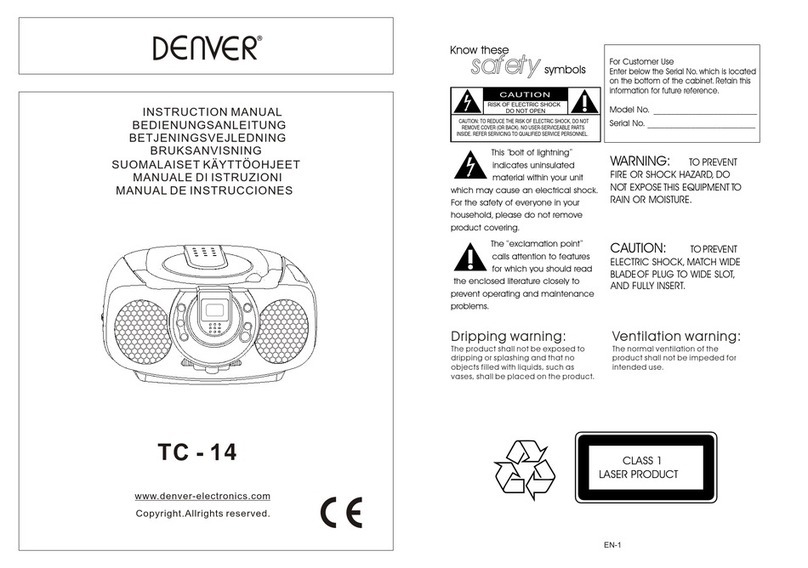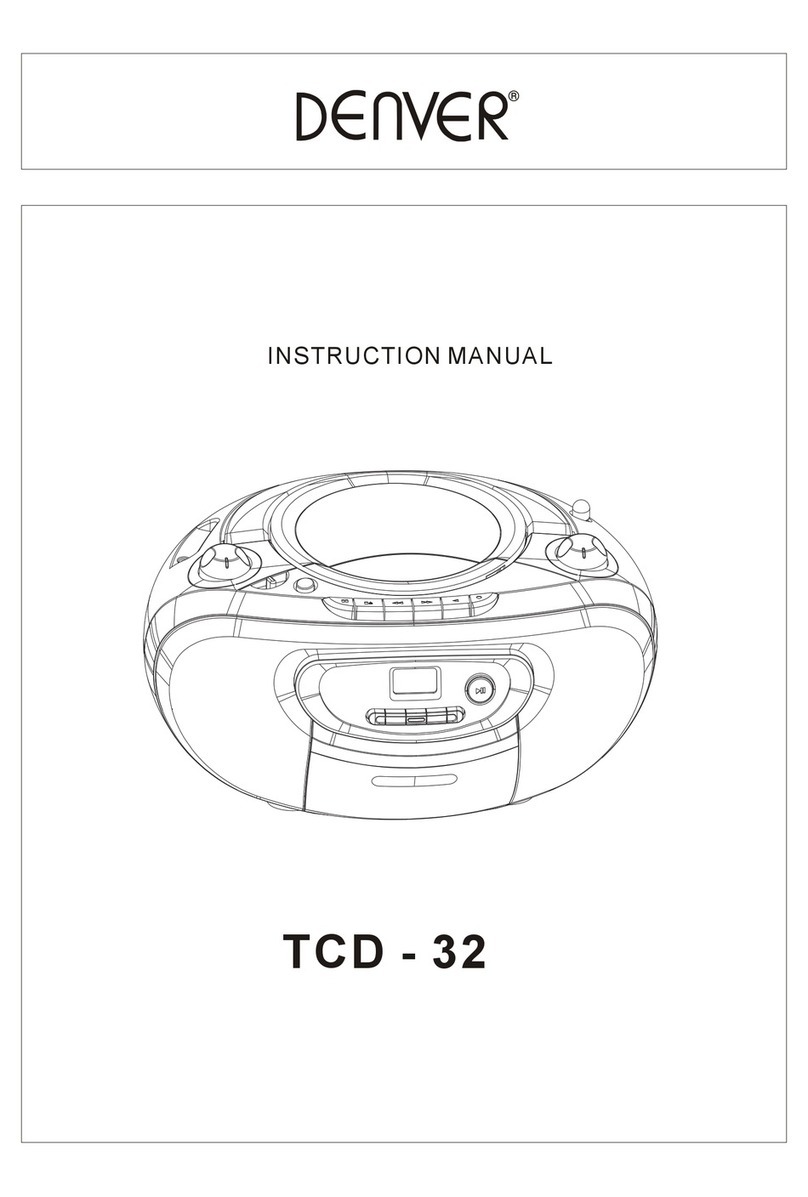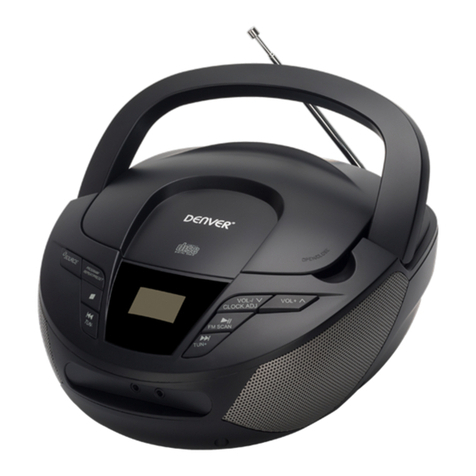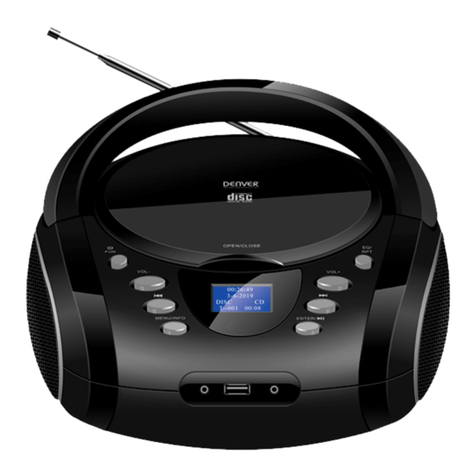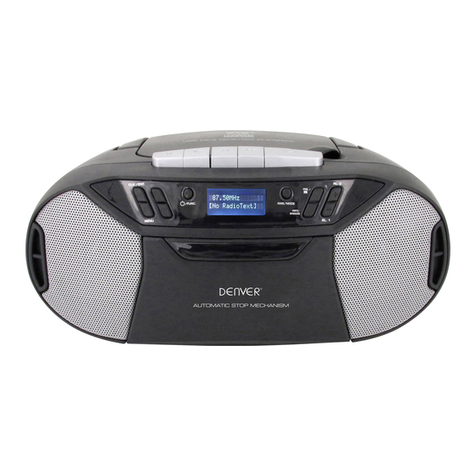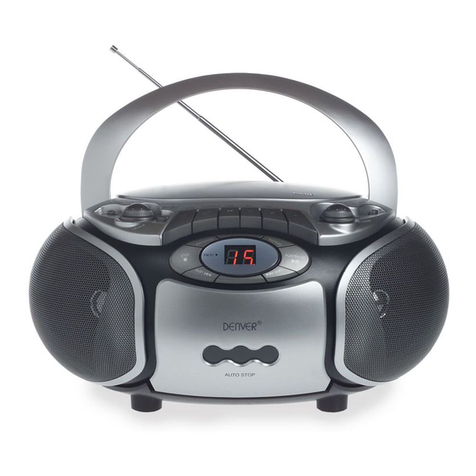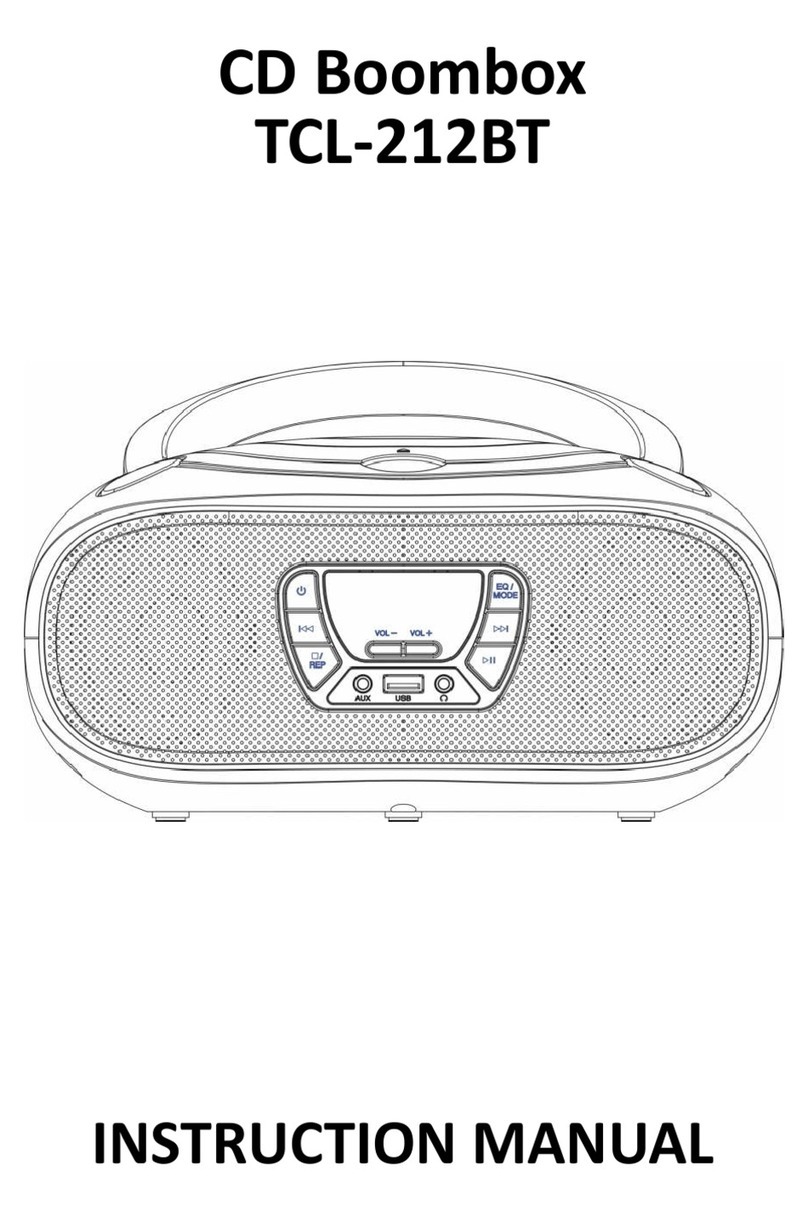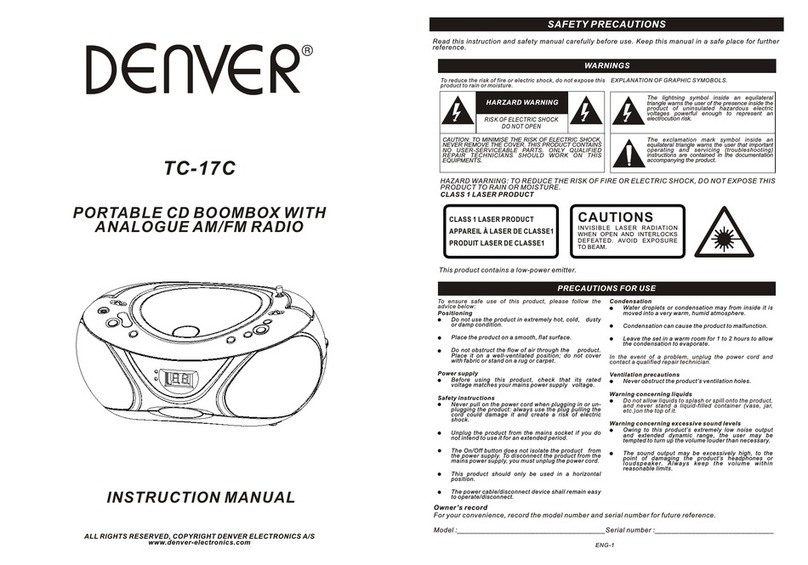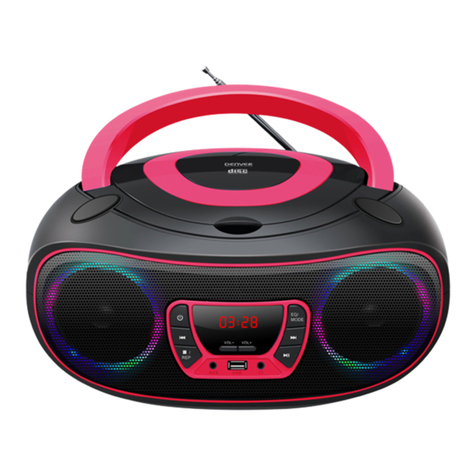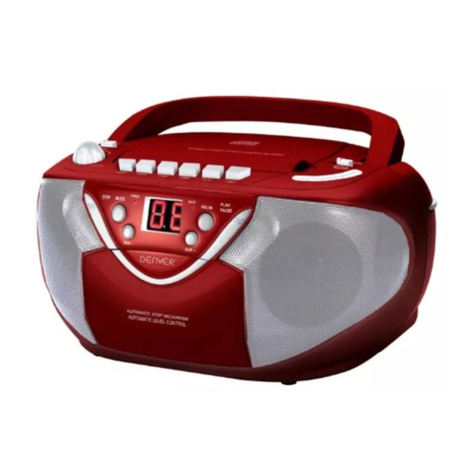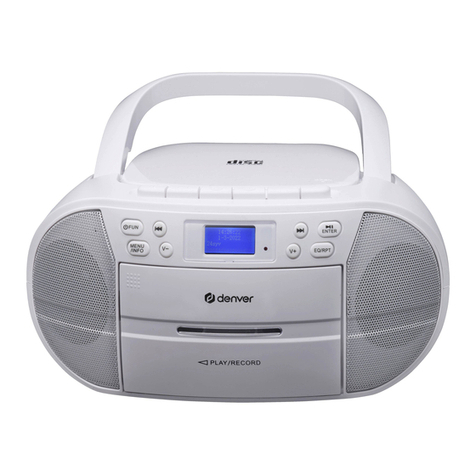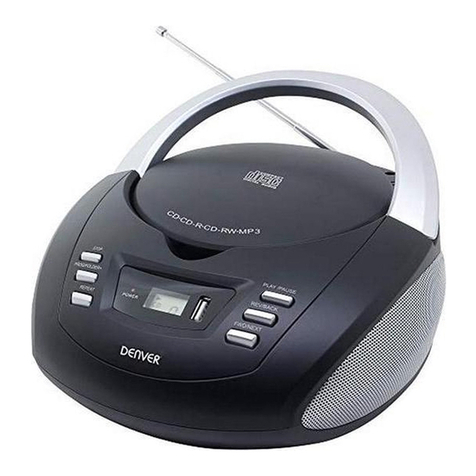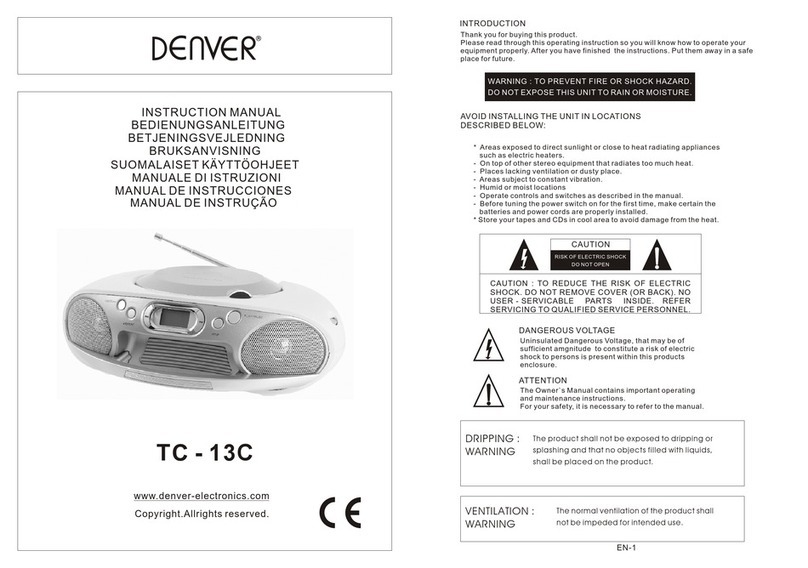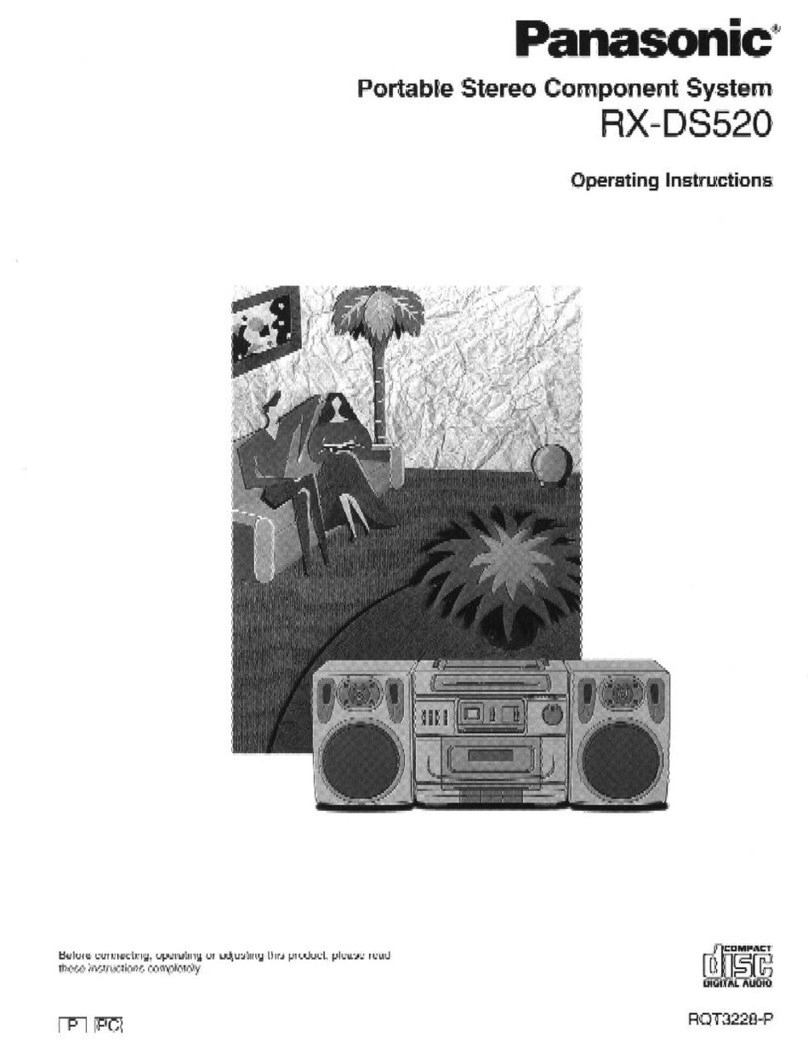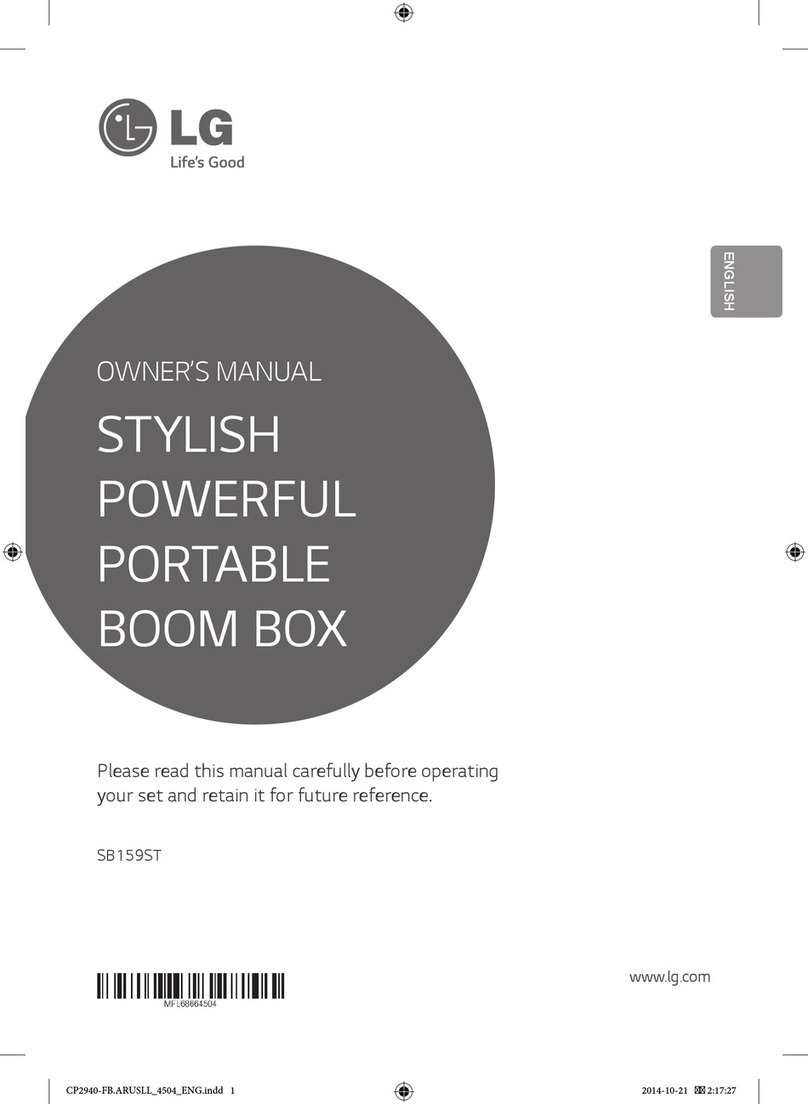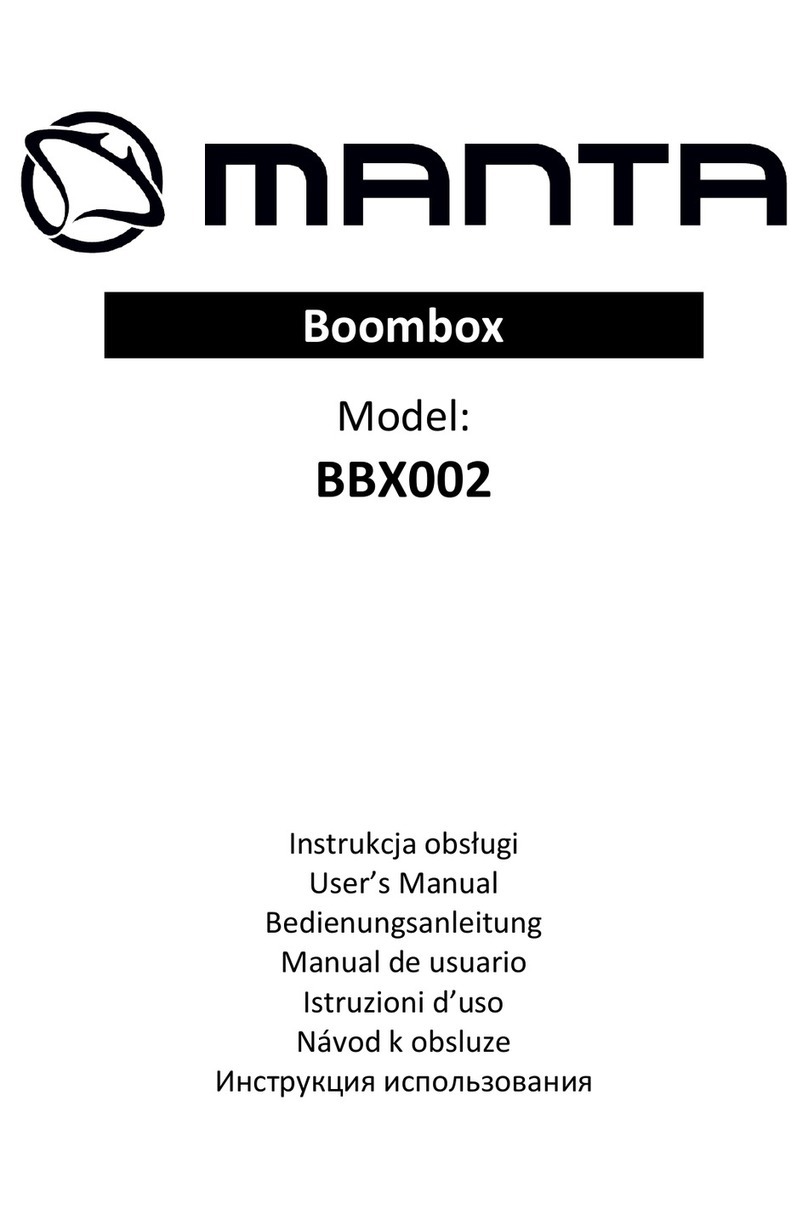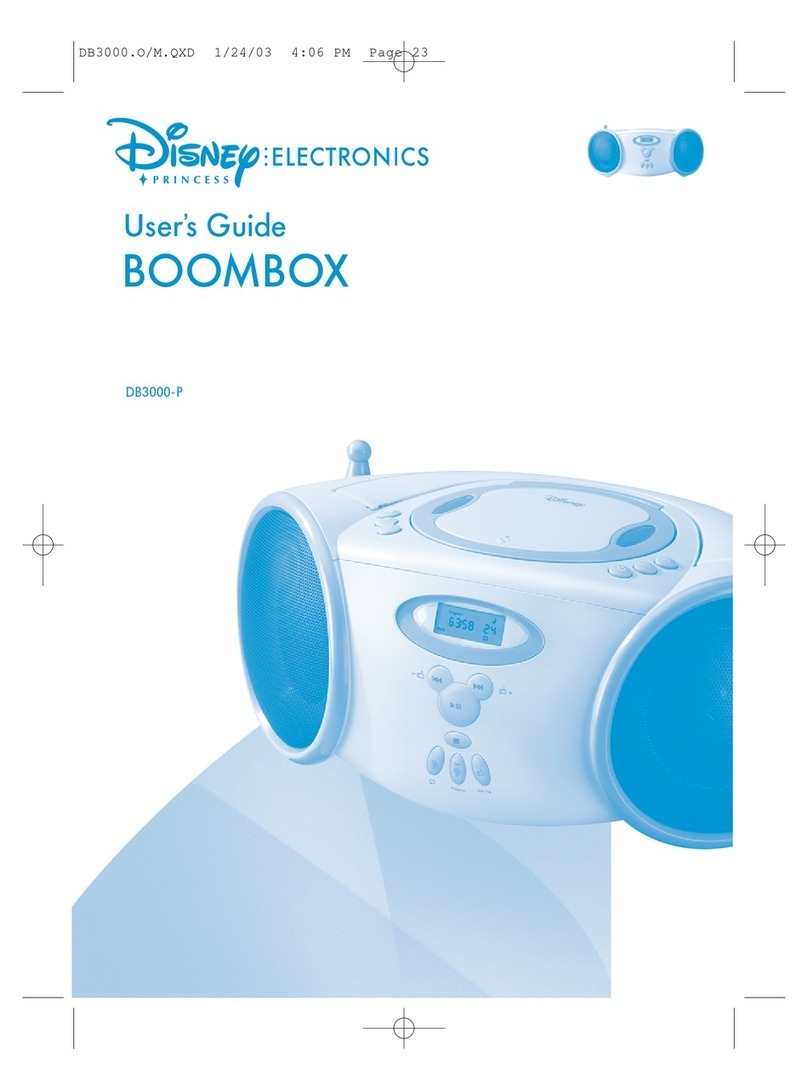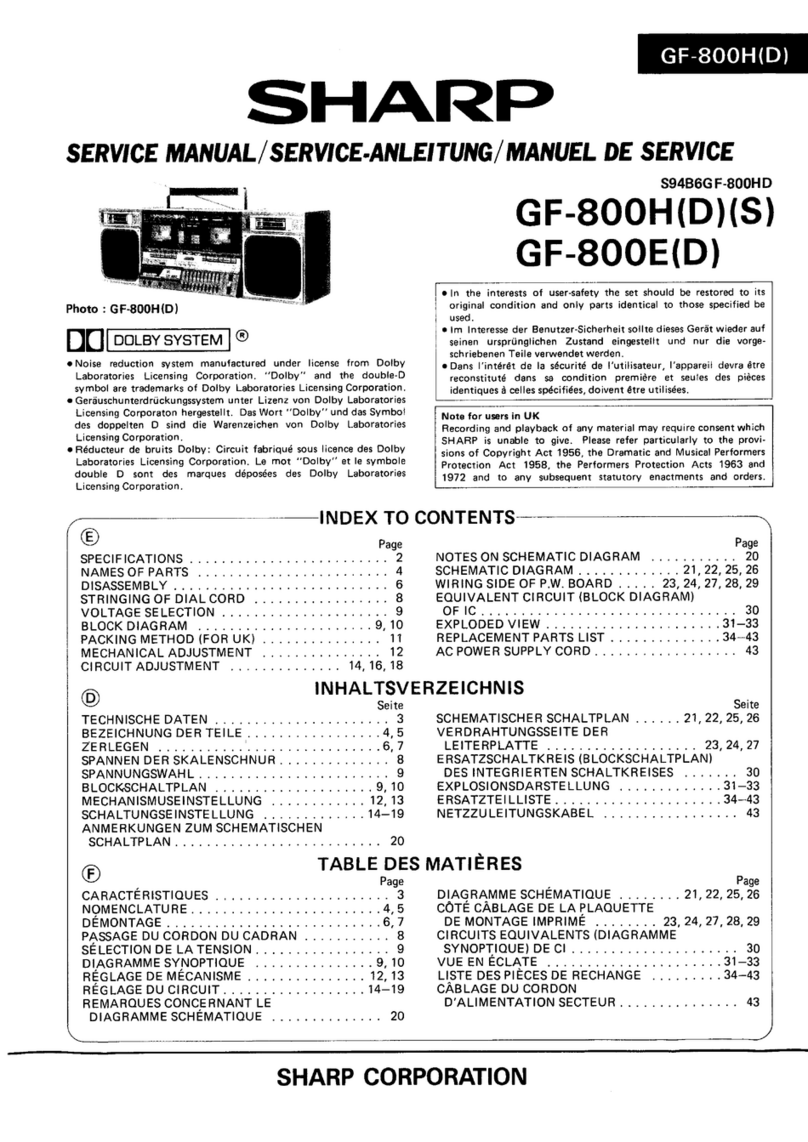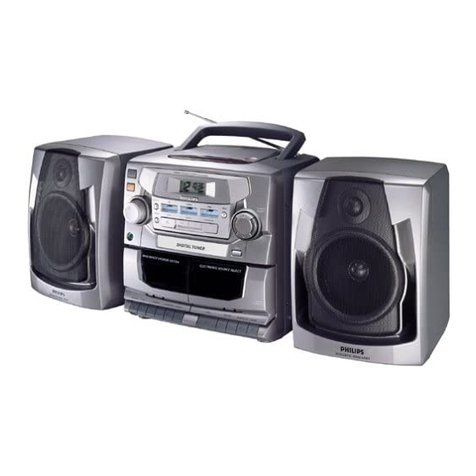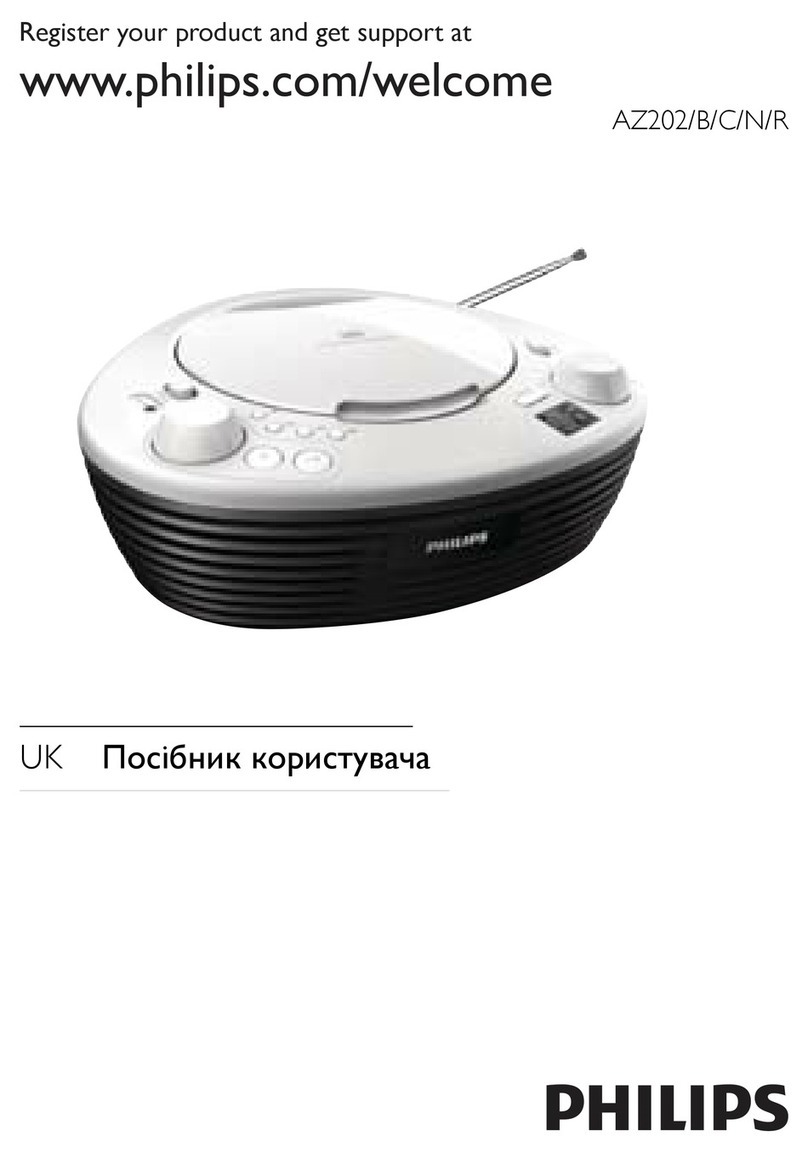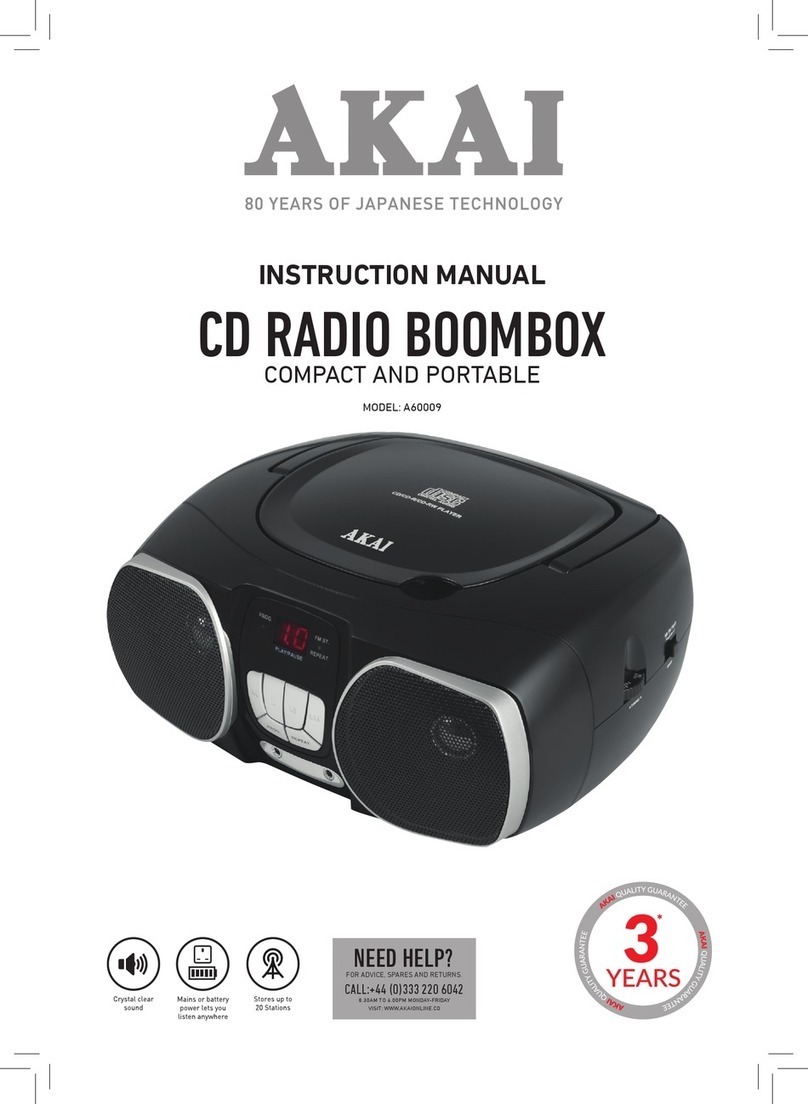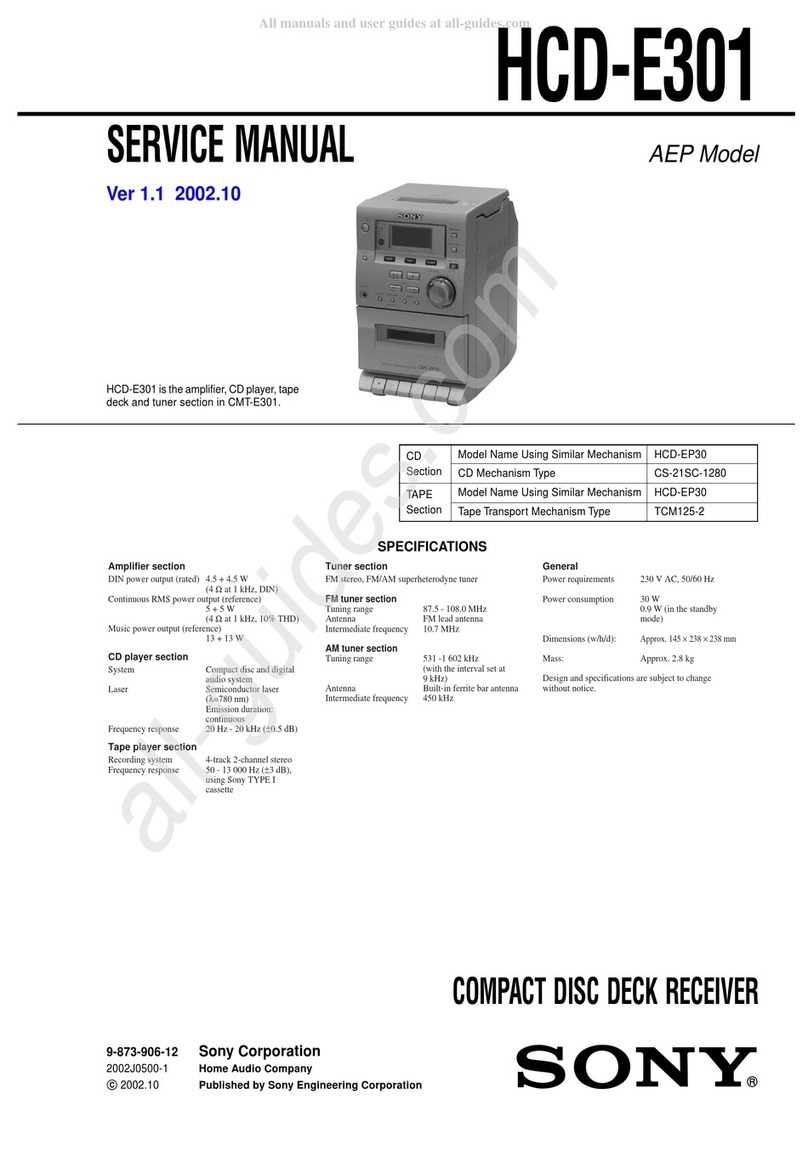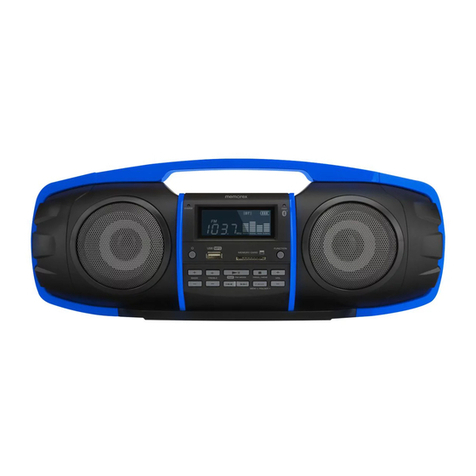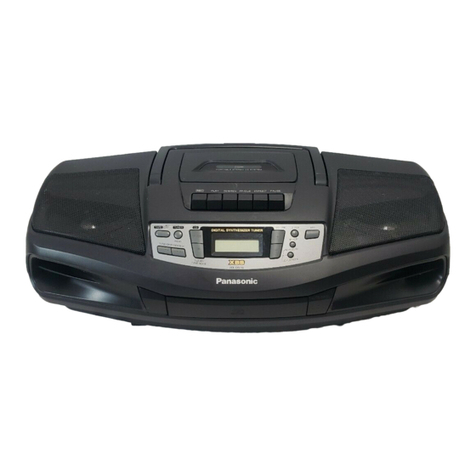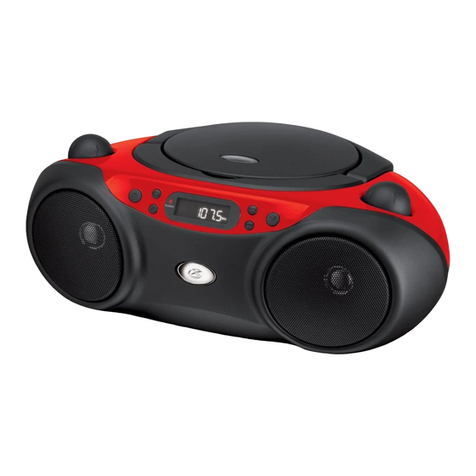1Set function to RADIO.
2Select a band with BAND.
3Tune to a station with TUNING.
4Turn VOLUME and press the BBS to adjust the sound.
For better reception - Extend the FM antenna and orient
it for the best reception; AM antenna is inside the unit.
Position the unit for the best reception.
FM /FM ST
Sets the FM sound to stereo or monaural.
F TUNER OPERATION
FM ST: Reception is stereo. When receives FM stereo
signal, the FM ST indicator lights up.
FM: When an FM stereo broadcast contains noise,
set to FM. Noise is reduced, although reception is
monaural.
When recording a radio program, an irritating "whistling"
sound may sometimes be heard. If this occurs, select
position 1 or 2. Leave the switch in the position that
gives the best results.
BEAT CANCEL SWITCH ON AM
C POWER SUPPLY
D MAINTENANCE
To clean the cabinet
Use a soft cloth lightly moistened with mild detergent
solution. Do not use strong solvents such as alcohol.
benzine or thinner.
To clean the heads and tape paths
After every 10 hours of use, clean the Recording heads
and Playback head , the pinch roller and capstan .Use
a cotton swab 5 slightly moistened with cleaning fluid
or denatured alcohol.
Cassette tapes
To prevent accidental erasure, bread off the plastic tabs
on the cassette tape after recording with a screwdriver
or other pointed tool.
To record on the tape again, cover the tab openings with
adhesive tape, etc.
E CD OPERATION
IMPORTANT
Make sure that f is set to TAPE before connecting
the AC cord or inserting batteries.
CAUTION
Use only the supplied AC cord. Use with other cords may
result in the risk of fire.
Before operating the unit for the first time or operating the
unit in a new area, it is essential to assure that the setting
of the VOLTAGE SELECTOR corresponds with the local
voltage. To adjust the voltage, set the
Using on batteries
Open the lid of the battery compartment on the rear and
unction
VOLTAGE SELECTOR
to the local voltage with a screw driver.
The batteries need to be replaced when:
The tape speed slows down, volume decreases, or
sound is distorted during operation.
notes on batteries
Do not mix different types of batteries or old batteries
with new ones.
Never recharge the batteries, apply heat to them or
take them apart.
Remove dead batteries.
If liquid leaks from the batteries, wipe thoroughly to remove.
insert eight (size D) batteries, not supplied, with the and
marks correctly aligned. then close the lid.
To switch from AC power supply to battery power supply,
disconnect the AC cord from the AC inlet.
EQ
CLASSIC ROCK JAZZ POP
NORMAL REPEAT ONE REPEAT ALL
SHUFFINTRO
REPEAT 1 :"REPEAT 1" light on display and will
repeat the track you selected.
REPEAT ALL: "REPEATALL"light on display and will
repeat entire tracks.
INTRO: "INTRO"light on display andwill play the first
10 seconds of each tracks..
SHUFF:"SHUFF"light on display,Plays every tracks in
random order .
ANTI SHOCK: "ESP"light on display, and will
anti-shock 45 seconds.
CD DISC MODE KEY
PROGRAM:
1.Press "PROG" KEY, Then "PROG 00" start flashing.
2.Press skip/searched or key tosearch the
track Number.
3.When desired track is display, press PROGRAM
key to register. Then track no display to "00"
display to "00" again.
4.Repeat 2-3 (up to 60tracks) after register 60
tracks. display shows the firstregistered track.
5.Registered tracks can be checkby press"PROG"
key, and itcan be changed by repeat 2-3.
6.Press play key,then "PROG" stops flashing and
starts playing.
REPEAT 1: "REPEAT1" light on display and will repeat
the track you selected.
REPEAT DIR: "REPEAT DIR" Repeat one directory.
REPEAT ALL: "REPEAT ALL "light on display and will
repeat entire tracks.
SHUFF: "SHUFF" light ondisplay plays every tracks in
random order.
INTRO: "INTRO"light on display playsand will play the
first 10 seconds of eachtrack.
ANTI SHOCK: anti-shock about 120 seconds default
when playing MP3 ,and "ESP"not display.
NORMAL REPEAT 1 REPEAT DIR
INTRO SHUFF REPEAT ALL
MP3 DISC MODE KEY
PROGRAM:
1.Press "PROG" key at STOP state, Then "00" in
"PGM 00 00-01"will flashing.
2.Press skip/searched or key tosearch the track
Number.
3.Press down "PROG" key they"00P" in "PGM 00 00P-01".
4.Press skip/searched or key tosearch the track
Number.
5.When desired track is display, press PROGRAM key
to register. Then track no. display to "00" again.
6.Repeat 2-5 (up to 60files) after register 60 files.
display shows the first registeredtrack.
7.Registered tracks can be checkby press "PROG"
key, and itcan be changed by repeat2-5.
8.Press play key,then PROG stops flashing and starts
playing.
Use Type 1 (normal) tapes only.
PLAYING BACK A TAPE
1 Set to TAPE.
2Press STOP/EJECT to open the cassette
holder and insert a tape with the exposed side up and
the side to be played facing out.
3Press PLAY to start play.
4Turn VOLUME and press the BBS to adjust the sound.
STOP/EJECT - Stops play.
PAUSE - Pauses play. To resume play, press again.
F FWD/ REW - Fast forwards/rewinds. To
stop winding. press STOP/EJECT.
function
G TAPE OPERATION
RECORDING
Note that recording is done on only one side of the tape.
1Insert a tape with the side to be recorded facing out.
Wind up the tape to the point where recording starts.
2Get ready to record from the source.
To record from a CD: set function to CD and start play.
To record from the tuner: set function to RADIO and
tune to a station.
To record from built in MIC: set function to TAPE
3Press REC to start recording.
PLAY is pressed simultaneously.
To stop recording, press STOP/EJECT.
To erase a recording, set function to TAPE and start
recording.
To turn off the unit, set function to TAPE.
To listen with the headphones, connect headphones with a stereo mini plug to the PHONES jack.
If an erroneous display or malfunction occurs, disconnect the AC cord and remove all the batteries to turn off the
display. Then turn the power back on.
H GENERAL
COPYRIGHT
Please check the copyright laws relating to recordings from disc, radio or external
tape for the country in which the machine is being used.
I SPECIFICATIONS
General
Speaker: 92 mm cone type (2)
Output: Headphones jack (stereo jack)
Power output: 1.0 W +1.0 W
Power requirements: DC 12 V using eight size D batteries,
AC 230V, 50Hz
Weight: 2.9Kg (excluding batteries)
Dimensions: 334(W)x181(H)x255(D) mm
Accessory: AC cord (1)
Specifications and external appearance are
subject to change without notice.
Tuner section
Frequency range: FM : 88-108 MHz
AM : 525-1630 KHz
Deck section
Track format: 4 track, 2 channels
Frequency range: Normal tape
Recording system: AC bias
Erasing system: Magnet erase
Heads: Recording / playback head
Erasure head
CD player section
Disc: Compact disc
Scanning method: Non-contact optical scanner
(semiconductor laser)
7.To clear programing. press the "STOP" key, then
press "PROG" key to programstate, then press
"STOP" key ,or open thedoor or power off.
9.To clear programing. press the STOP key then press
"PROG" key to program state,then press "STOP" key,
or open the door orpower off.
